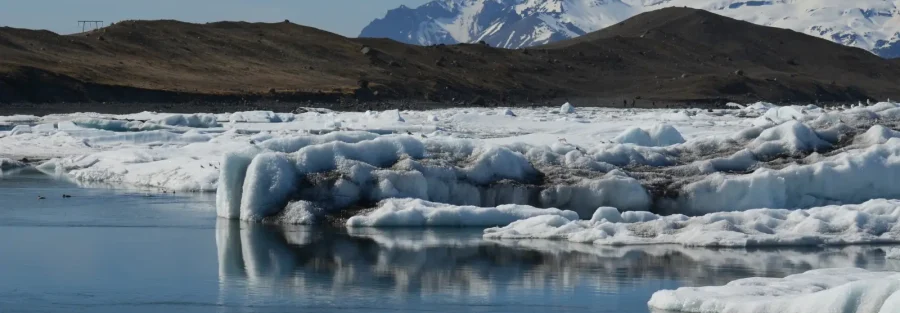Why 2025 Must Be the Year We Preserve Our Frozen Heritage
The Benchmark Loss That Sparked Global Alarm
Glaciers worldwide are losing 273 billion tonnes of ice annually, according to a major international study published in Nature this February. To grasp this scale, imagine the entire global population’s water consumption for 30 years disappearing each year. Between 2000 and 2023, glaciers lost 5% of their remaining ice, with some regions suffering catastrophic losses. Central Europe has lost almost 40% of its glacier volume in just two decades.
These figures represent more than climate statistics. They chronicle the disappearance of irreplaceable natural archives that have recorded Earth’s atmospheric history for millennia. Since 1970, reference glaciers tracked by the World Glacier Monitoring Service have lost ice mass equivalent to nearly 27.3 meters of liquid water, fundamentally altering the planet’s water systems. Yet despite this accelerating crisis, our response remains fragmented and underfunded.
Blatten Collapse as Seismic Event
In May 2025, the sudden collapse of the Blatten Glacier in Switzerland sent shockwaves through both the local community and the scientific world. The resulting avalanche killed one person, caused $400 million in damages, and triggered a magnitude 3 earthquake. A glacier that had withstood centuries was erased in hours. The question remains: what if we had treated glaciers like we do irreplaceable art?
Art is protected, displayed, archived, and even insured. Glaciers, in contrast, are melting away, largely ignored until they trigger disasters.
The Museum Model
Museums worldwide spend millions annually preserving Renaissance masterpieces because we recognize their irreplaceable cultural value. Meanwhile, the Gangotri Glacier, which feeds the Ganges River and sustains 400 million people, retreats 22 meters annually with minimal protection or dedicated funding.
This disparity reveals a fundamental flaw in how we value natural heritage. Art conservation operates through sophisticated legal frameworks, international treaties, and dedicated funding streams. The 1970 UNESCO Convention prevents trafficking in cultural property and mandates heritage protection. National systems designate historic landmarks with legal standing equivalent to national parks. Insurance markets cover masterpieces for hundreds of millions of dollars, creating financial incentives for preservation.
Glaciers receive none of these protections despite their far greater importance to human survival. They regulate global climate systems, provide fresh water to over 2 billion people, and maintain delicate ecosystems across continents. Once lost, unlike damaged art, they cannot be restored.
The Legal Blueprint
2025 has been declared the International Year of Glaciers’ Preservation by UNESCO and the World Meteorological Organization, creating unprecedented momentum for systematic glacier protection. This initiative recognizes that glaciers require the same institutional framework that safeguards cultural treasures.
The art world’s protection model offers precise legal templates. An “International Convention on Cryospheric Heritage” could mandate glacier monitoring, restrict harmful activities in glacial watersheds, and establish liability for industrial damage to ice systems. National governments could create “Critical Glacier Reserves” with legal protections equivalent to national historic landmarks, prohibiting mining and limiting tourism infrastructure.
In 2017, New Zealand granted legal personhood to the Whanganui River. In 2021, Bangladesh declared all its rivers living entities. Why not glaciers?
Legal personhood for glaciers would mean the ability to sue on their behalf, create conservation funds, and block development that threatens their existence. Switzerland, Nepal, and Peru have shown legal interest in environmental personhood. If scaled globally, this could mark a foundational shift in how we defend glaciers.
Insurance markets already demonstrate how financial mechanisms drive conservation. Industries operating near glaciers could purchase mandatory “glacier impact insurance” that funds restoration efforts and compensates affected communities. This approach transforms ice preservation from voluntary environmental gesture into binding legal obligation.
Engineering Solutions With Surgical Precision
Switzerland already covers sections of the Rhone Glacier with reflective materials each summer, reducing melting by 70% in treated areas. This localized success proves that targeted engineering can preserve ice, but the approach needs strategic scaling rather than global application.
Satellite monitoring and artificial intelligence can identify the world’s 200 most critical glaciers based on water security impact, flood risk, and ecosystem stability. Focusing engineering interventions exclusively on these high-priority targets maximizes resource efficiency. Advanced aerospace materials could cover larger glacier areas at reduced costs, while controlled glacier lake drainage systems prevent catastrophic outburst floods before they occur.
Norway has successfully implemented proactive lake management, preventing fourteen potential flood disasters since 2020. Despite heavy snowfall in 2024, Swiss glaciers still lost 2.5% of their volume during the summer, demonstrating that natural variation cannot offset sustained warming trends. Strategic intervention remains essential.
The Economics
Current global climate finance distributes hundreds of billions across scattered initiatives. Glacier protection requires concentrated, dedicated funding comparable to major infrastructure projects. Allocating just 1% of global military spending would provide $25 billion annually for comprehensive glacier monitoring, strategic engineering, and community protection systems.
Private collectors insure rare paintings for hundreds of millions. Entire auction markets exist to quantify and assign value to brushstrokes. If a glacier’s melt directly impacts agriculture, tourism, and drinking water, it clearly holds value — economic, strategic, and emotional.
In Bhutan, hydropower generated by glacial rivers accounts for 30% of GDP. In Pakistan, glacier loss has led to recurring floods and displacements. In the Alps, loss of glacier tourism is costing millions annually. The numbers are here — they just need to be accounted for in a global economic framework.
Climate funds should consider glaciers not as background climate features but as frontline economic assets worth preserving.
This investment generates measurable returns. Every dollar spent on glacier preservation saves approximately $7 in flood damage prevention, water infrastructure costs, and agricultural losses. Carbon tax revenues could be partially earmarked for ice preservation, while tourism levies in glacial regions create sustainable funding streams. The Alps alone attract 50 million visitors annually, generating substantial potential revenue for glacier protection.
The Asian Development Bank recently launched its “Glaciers to Farms” program to promote sustainable water use across Central Asia, the South Caucasus, and Pakistan amid accelerated glacial melt. Such initiatives demonstrate growing institutional recognition that glacier preservation requires dedicated financial mechanisms rather than general climate funding.
Risk Management: From Reactive to Predictive
Traditional glacier monitoring focuses on long-term trends rather than immediate hazards. A comprehensive protection framework requires real-time risk assessment systems comparable to earthquake or hurricane monitoring. Standardized glacier hazard ratings could trigger automatic evacuation procedures, infrastructure restrictions, and emergency funding releases.
Continuous sensor networks tracking ice movement, temperature changes, and structural stress provide early warning capabilities. When glaciers show signs of instability, communities need advance notification rather than post-disaster response. Insurance requirements for infrastructure projects within 50 kilometers of ice systems would mandate glacier risk assessments and mitigation funding.
The G-Zero Coalition, launched at COP29 in Baku, provides a framework for glacier-dependent nations to coordinate zero-carbon development pathways. Countries like Bhutan are modeling how glacier preservation can align with sustainable economic growth.
Implementation: The Five-Year Framework
Year one requires establishing legal foundations: drafting international cryospheric heritage conventions, creating national glacier protection agencies in key countries, and standardizing monitoring protocols. The International Conference on Glaciers’ Preservation scheduled for Dushanbe in May 2025 offers a crucial opportunity to formalize these frameworks.
Years two and three focus on infrastructure development: installing monitoring systems on priority glaciers, launching pilot engineering interventions in the Alps, Himalayas, and Andes, and establishing a dedicated Glacier Heritage Fund with substantial initial capitalization. Years four and five emphasize scaling: expanding monitoring networks, implementing glacier risk insurance requirements, and launching global public awareness campaigns.
This timeline aligns with existing climate commitments while creating specialized mechanisms for ice preservation. Success requires treating glacier protection as a distinct challenge requiring dedicated institutions, not merely another component of general environmental policy.
Cultural Transformation
The deepest change involves cultural perception. Indigenous communities have always understood glaciers as sacred heritage. Quechua people consider ice mountains sacred ancestors, while Inuit languages contain dozens of words for different ice types, each with spiritual significance. Modern societies need equivalent cultural frameworks for valuing frozen landscapes.
Educational systems could teach children about the Columbia Icefield alongside lessons about the Sistine Chapel. When archaeological sites are destroyed, we mourn cultural loss. The disappearance of glaciers deserves equal recognition as irreplaceable heritage destruction.
This transformation has precedent. The 1972 World Heritage Convention created international legal protection for cultural and natural sites. Today, 1,154 locations across 167 countries receive protected status and dedicated funding. Marine Protected Areas now cover 8% of the world’s oceans, up from virtually zero in 1970. Coordinated international action, supported by legal frameworks and sustained funding, can preserve critical natural systems.
A Choice Still Within Reach
Under a two-degree warming scenario, melting glaciers are forecast to cause 99 millimeters of sea level rise by 2100. These projections assume current emission trajectories continue unchanged. But they also represent preventable outcomes if comprehensive preservation efforts begin immediately.
The choice before us mirrors decisions made to save endangered species, preserve historic cities, and protect cultural artifacts. We possess the legal frameworks, technological capabilities, and financial resources needed to preserve glaciers. What we lack is the institutional will to apply these tools systematically.
Preserving Ice as a Masterpiece
If we begin treating glaciers as irreplaceable treasures requiring the same protection as the Mona Lisa, future generations will inherit landscapes shaped by ice rather than scoured by its absence. The frozen archives containing centuries of climate history will continue recording Earth’s story. The rivers that sustain billions of people will flow with glacial melt rather than run dry.
The transformation requires treating ice as heritage, not scenery. It demands legal protection, not voluntary guidelines. It needs dedicated funding, not scattered climate initiatives. Most fundamentally, it requires recognizing that glaciers are masterpieces we cannot afford to lose.
Time moves differently for ice and art, but both demand our urgent attention before they disappear forever.





